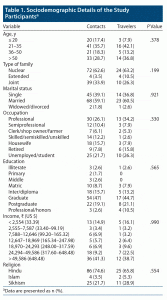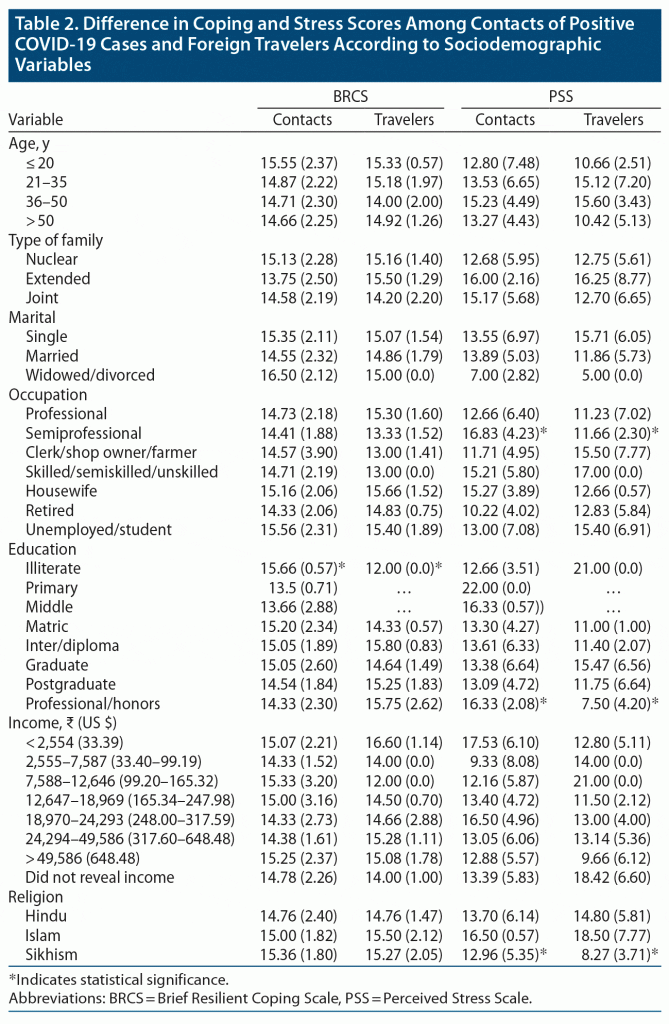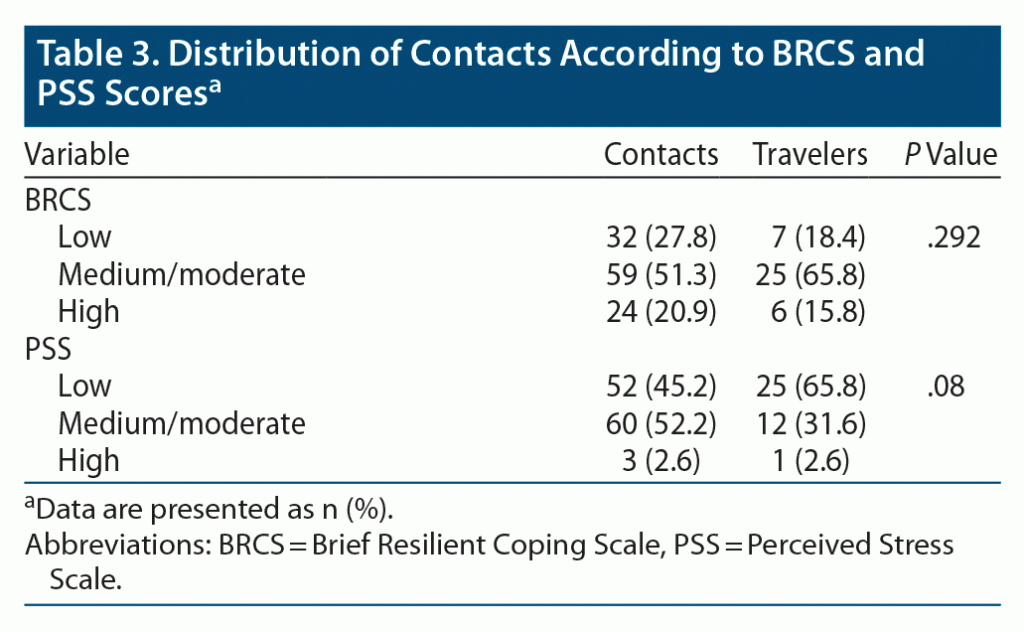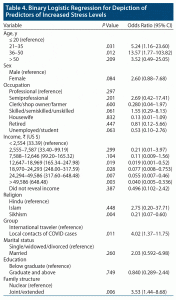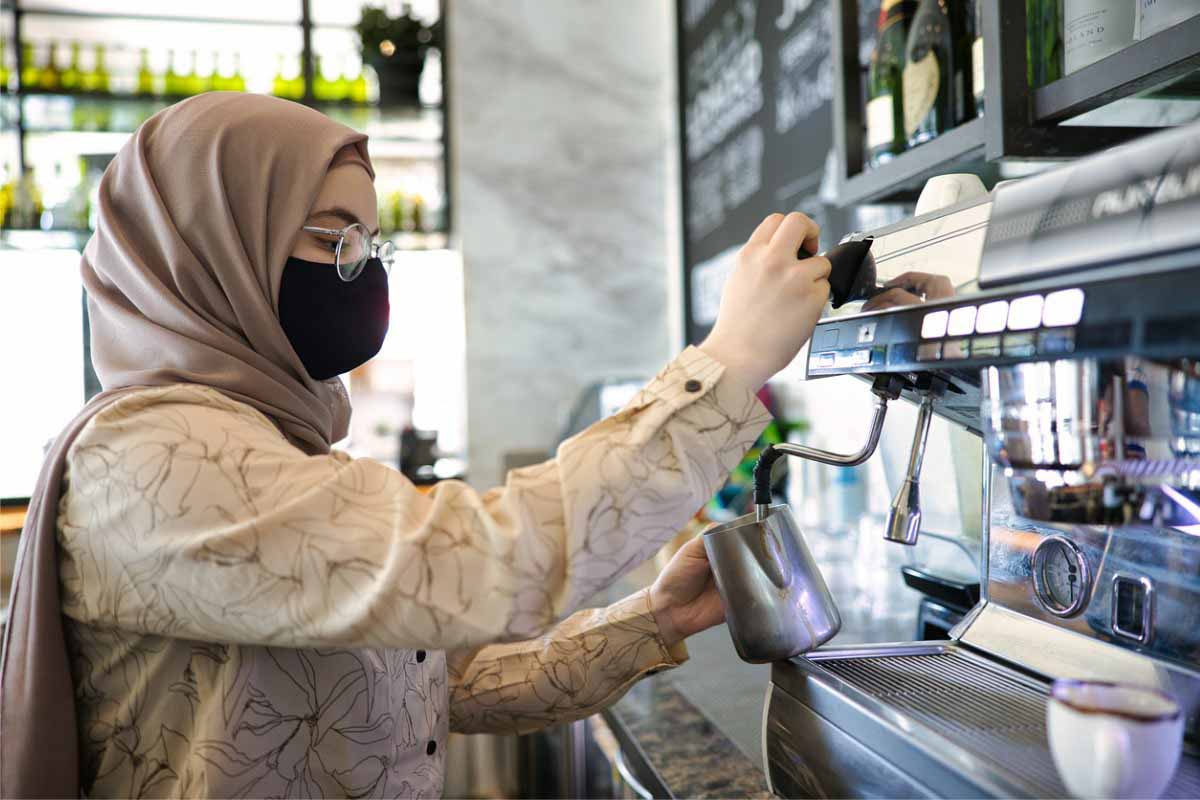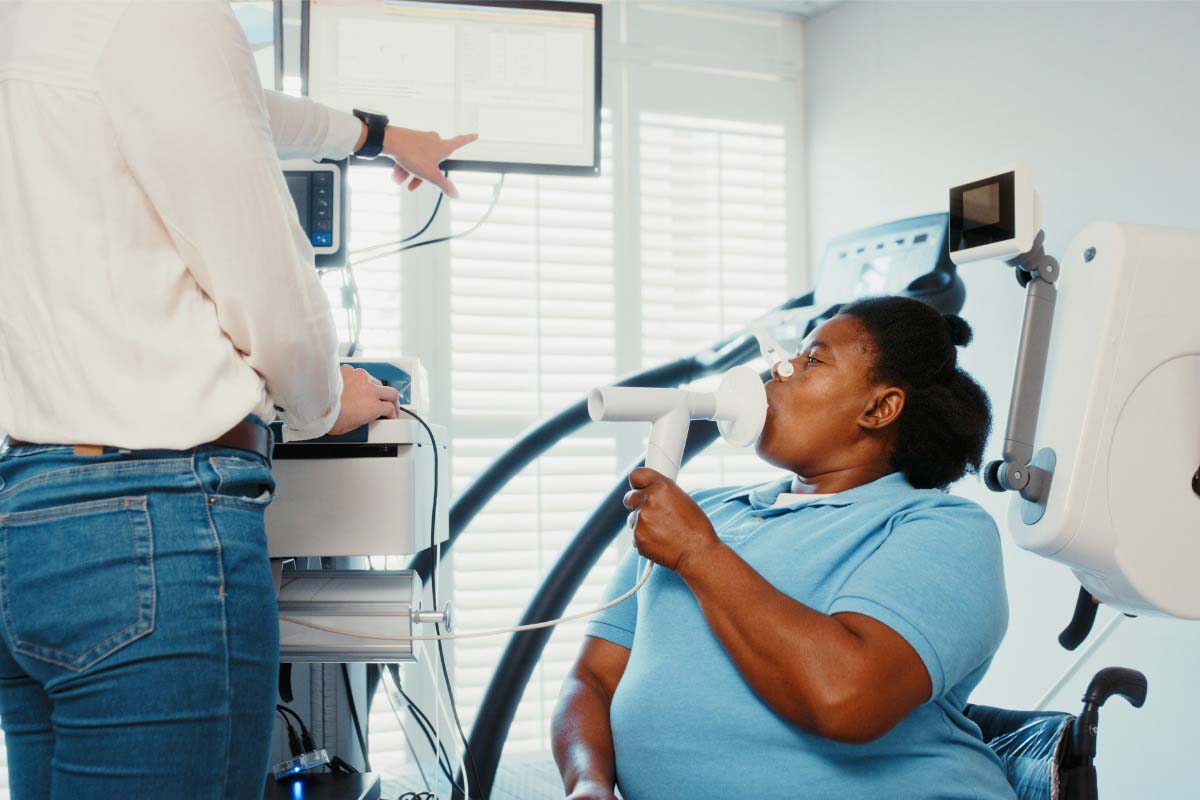ABSTRACT
Objective: To assess stress, coping, and resilience among home-quarantined individuals via a community survey during the coronavirus disease 2019 (COVID-19) pandemic.
Methods: In this cross-sectional study, a combined list was generated of all contacts of positive COVID-19 cases, traced by a contact tracing team, and international travelers who had entered the country after March 8, 2020 (2 weeks before the air travel shutdown on March 22, 2020 in India). This community-based study was conducted among people who were quarantined in their homes and international travelers who arrived in the country after declaration of lockdown. Stress and coping were assessed via the 12-item General Health Questionnaire, 10-item Perceived Stress Scale, and Brief Resilient Coping Scale. The participants with higher perceived stress scores (≥ 14) were asked to seek help from telemedicine services. Study data were collected from April 8, 2020, to May 20, 2020.
Results: The mean age of the 153 study participants was 40.10 years, and 41.8% were women. Poor coping was identified in 25.5% of the sample, and moderate/high stress was present in 49.7%. Significantly higher stress was noted in women (P = .007). Higher age, joint family structure, and contacts of COVID cases were significant predictors of moderate/severe perceived stress in the logistic regression.
Conclusions: Adequate psychological supportive services should be provided to home-quarantined persons through provision of information, rapid communication, and timely supplies of general and medical items.
Prim Care Companion CNS Disord 2022;24(2):21m03080
To cite: Das S, Goel NK, Tyagi S, et al. Stress, coping, and resilience among home-quarantined persons during the COVID-19 pandemic: findings from a community study. Prim Care Companion CNS Disord. 2022;24(2):21m03080.
To share: https://doi.org/10.4088/PCC.21m03080
© Copyright 2022 Physicians Postgraduate Press, Inc.
aDepartment of Psychiatry, Government Medical College and Hospital, Chandigarh, India
bDepartment of Community Medicine, Government Medical College and Hospital, Chandigarh, India
*Corresponding author: Ravi Rohilla, MD, Department of Community Medicine, Government Medical College and Hospital, Sector-32, Chandigarh, India ([email protected]).
Quarantine is an age-old strategy used for containment of infectious diseases that has been utilized to control the coronavirus disease 2019 (COVID-19) pandemic. Recently, many individuals with suspect cases of COVID-19 were advised to self-quarantine in their homes. Quarantine measures focus on restricting movements and separating people potentially exposed to a contagious disease to ensure that the risk from these individuals infecting others is reduced.1
Several qualitative studies2–5 conducted focus group discussions, surveys, and semistructured and structured interviews to identify common problems that emerged from conversations with those who experienced quarantine. The respondents reported emotional difficulties such as feeling anxious, irritable, and depressed. Lack of proper communication, frustration, fear, boredom, sleep difficulties, somatic complaints, feeling helpless, and being worried were the other common problems that emerged.2–5 The present study aimed to assess stress, coping, and resilience among home-quarantined individuals via a community survey.
METHODS
This cross-sectional study was conducted in Chandigarh, which is an urban city in North India. The Departments of Psychiatry and Community Medicine of Government Medical College and Hospital, Chandigarh, India, collaborated for this study. The study data were collected from April 8, 2020, to May 20, 2020. The participants, who were aged ≥ 18 years, were contacts of cases of COVID-19 or international travelers who were home quarantined after entering the country on March 8, 2020. The questionnaire was made available in the English, Hindi, and Punjabi languages. Written informed consent was received from each participant before commencement of the study, and the assessment procedure with each participant took approximately 50 to 60 minutes. The study was approved by the institutional ethics committee.
Sample Size
For sample allocation among contacts of positive cases and air travelers who were home quarantined, population proportionate to size method was adopted. Assuming prevalence of psychological consequences among contacts of COVID-19 cases as 10% and precision of 5%, the minimum sample size was calculated as 139. For this study, we targeted 150 subjects.
Data Collection
A combined list of all contacts of positive COVID-19 cases, traced by the contact tracing team, and international travelers who had entered the country after March 8, 2020 (which was 2 weeks before the air travel shutdown on March 22, 2020) was generated along with their address and phone details. The list of recent air travelers, who were residents of Chandigarh, was received from the Chandigarh Directorate Health Services through the appropriate channel. Random contacts who were selected by computer-generated random numbers among home-quarantined individuals and foreign travelers were approached by the research team comprised of trained research staff with master’s degrees in social work. Patients with medical, surgical, or mental health conditions were excluded from the study. For subjects with limited literacy, the questionnaire was administered in the local vernacular language (Hindi and Punjabi), and responses were recorded.
Measures
Sociodemographic details were obtained, which included age, type of family, marital status, education, occupation, income, and religion. All eligible participants were administered the 12-item General Health Questionnaire (GHQ-12),6,7 the 10-item Perceived Stress Scale (PSS-10),8,9 and the Brief Resilient Coping Scale (BRCS).10 The participants with higher perceived stress scores (≥ 14) were asked to seek help from telemedicine services provided by the Department of Psychiatry through a toll-free number.
Statistical Analysis
The data were entered and checked for accuracy. Data analysis was conducted using SYSTAT software for Windows version 13.2. Qualitative data were presented as frequency and proportions, whereas quantitative data were depicted as mean and standard deviation. Independent t test (Mann Whitney if normality violated) was used for comparison of 2 groups with continuous data. Statistical significance was considered as P < .05.
RESULTS
The mean (SD) age of the respondents was 40.10 (17.54) years, with a range of 18–85 years. The sample comprised more men (58.2%) than women (41.8%). Of 153 participants, 35 (22.9%) chose not to reveal their income. The participants included 38 (24.8%) foreign travelers. Sociodemographic details of the contacts of positive COVID-19 cases and foreign travelers, which were statistically similar in both groups, are provided in Table 1.
Table 2 shows the difference in coping and stress scores among local contacts and foreign travelers. Coping scores were significantly higher among illiterate local contacts compared to foreign travelers (P = .032). Significantly higher stress scores were found among local contacts with a semiprofessional occupation (P = .041), with a professional education (P = .022), and who were Sikh by religion (P = .013).
Coping and perceived stress scores were similar, with no statistically significant differences between local contacts and foreign travelers. There were significantly higher mean (SD) perceived stress scores among women (15.15 [5.26]) compared to men (12.32 [6.12]) (P = .007). However, scores were similar between both sexes regarding coping (P = .298) and the GHQ-12.
Table 3 depicts subjects regarding coping and perceived stress, with poor coping among 25.5% and high perceived stress among 2.6% of the total sample. The distribution of subjects was similar for both coping and perceived stress among contacts and foreign travelers. Regarding the GHQ-12, 106 (69.3%) had no psychological morbidity, whereas 47 (30.7%) did have psychological morbidity. The reliability coefficients of the scales used were GHQ-12: 0.806, PSS-10: 0.719, and BRCS: 0.603. Thirty (39.5%) of the participants who were referred for higher perceived stress scores connected to telemedicine services.
Table 4 highlights the sociodemographic predictors of moderate/severe perceived stress among participants. Older contact subjects from joint/extended families had higher odds of perceived stress.
DISCUSSION
Our findings show low perceived stress levels in 50.3% of the study population, closely followed by moderate stress levels in 47.1%, with only 2.6% reporting severe stress levels. Also, women had significantly higher perceived stress scores than men. In contrast, a study11 from India reported that about 80.8% of participants had severe stress levels. With the increasing number of days in quarantine, stress levels of the participants also increased.11 Regarding higher stress scores, women are more likely to report stress levels as well as their physical and emotional symptoms compared to men.
The subjects had similar sociodemographic characteristics across both groups, most likely due to the common cultural factors and residence of the subjects. The international travelers were local residents who had traveled abroad for business, education, or leisure activity. Coping and perceived stress scores were similar in both groups, with significantly higher stress scores among semiprofessional subjects, which includes those pursuing social work, journalism, librarianship, teaching, and nursing. Stress levels may have increased among semiprofessionals due to mandatory quarantine and limited scope of work from home.
A previous study12 reported that 2 of the most frequently cited issues associated with quarantine were emotional difficulties related to confinement and not getting paid due to having to miss work. During quarantine, various other stressors can be fear of infection, longer duration, inadequate supplies, frustration, and inadequate information. Also, it may be that stress present among subjects might not be due to fear of disease but to the restrictions stemming from quarantine itself. Financial loss and stigma can also cause significant stress post quarantine.13 A study14 from China using the Impact to Event Scale-Revised reported that 53.8% of respondents rated the psychological impact of outbreak and subsequent lockdown as a cause of moderate or severe stress.
Higher age, being a contact subject, and subjects belonging to joint/extended families were identified with increased odds of perceived stress. In an online study15 with 10.8% of subjects reporting stress due to lockdown restriction, female sex, lower education level, and unmarried status were significantly associated with depression, anxiety, and stress. Stress in higher age group subjects in the present study might be explained by risk of mortality, as they often have concomitant comorbid conditions. Also, compared to nuclear families, joint family members might have difficulty quarantining due to limited space and risk of spreading infection within the whole family. Another online study16 reported stress levels in 11.6% of subjects, with increased odds of stress among subjects with less family income, lower educational levels, and presence of binge drinking. The probable cause of higher stress among COVID contacts compared to international travelers is stigma regarding COVID-19 infection.
It is important for individuals to have effective coping strategies to utilize in stressful situations, as they may prevent experiences from leading to stress-related psychiatric disorders. Most of our study population had medium/moderate levels of coping skills with no significant difference among males and females. Coping measures among both sexes might include doing household chores, revisiting an old hobby, exercising, and yoga, which tend to provide a temporal escape from the perceived stressor.
In our study population, the majority had no psychological problems as assessed using the GHQ-12. This finding contrasts with an Indian study17 that reported greater psychological distress in quarantined children and adolescents than nonquarantined children and adolescents. Among those who had psychological morbidity, the main causes for stress were being worried, feeling helpless, and fear of catching infection.17
In our view, to improve stress levels in the quarantined population, it is imperative to disseminate adequate information regarding the disease and available emergency facilities. Social media (such as Facebook, Twitter, YouTube) is a powerful tool to do so while tackling the spread of false information. Other tools include text messages providing general information regarding COVID-19 (ie, hand hygiene, wearing of masks, vaccination) and COVID-appropriate behavior designed to increase family member participation to curb stress, implementation of telemedicine services with institutions, telecasting of self-care practices via video and audio messages, and publication of educational material in newspapers.
The limitations of this study include small sample size and difficulty in conducting face-to-face surveys during home quarantine. Furthermore, comparison between nonquarantined/quarantined populations and mandatory/voluntary quarantine populations could have been done.
CONCLUSION
This study revealed low to moderate stress levels perceived by the quarantined population with moderate resilience coping skills. Women reported higher stress levels. However, most of the study population had no psychiatric disorders. There is a need to identify groups at high risk for increased levels of stress so that the issue can be addressed through public health services and individuals can be provided adequate psychological support, including reliable information, rapid communication, and general (medical) supplies.
Submitted: July 24, 2021; accepted November 23, 2021.
Published online: February 24, 2022.
Potential conflicts of interest: None.
Funding/support: None.
References (17)

- Sharan P, Rajhans P. Social and psychological consequences of “quarantine”: a systematic review and application to India. Indian J Soc Psychiatry. 2020;36(5):112–119. CrossRef
- DiGiovanni C, Conley J, Chiu D, et al. Factors influencing compliance with quarantine in Toronto during the 2003 SARS outbreak. Biosecur Bioterror. 2004;2(4):265–272. PubMed CrossRef
- Mihashi M, Otsubo Y, Yinjuan X, et al. Predictive factors of psychological disorder development during recovery following SARS outbreak. Health Psychol. 2009;28(1):91–100. PubMed CrossRef
- Sun D, Yang D, Li Y, et al. Psychological impact of 2019 novel coronavirus (2019-nCoV) outbreak in health workers in China. Epidemiol Infect. 2020;148:e96. PubMed CrossRef
- Jeong H, Yim HW, Song Y-J, et al. Mental health status of people isolated due to Middle East Respiratory Syndrome. Epidemiol Health. 2016;38:e2016048. PubMed CrossRef
- Goldberg DP, Blackwell B. Psychiatric illness in general practice: a detailed study using a new method of case identification. BMJ. 1970;2(5707):439–443. PubMed CrossRef
- Sánchez-López M del P, Dresch V. The 12-Item General Health Questionnaire (GHQ-12): reliability, external validity and factor structure in the Spanish population. Psicothema. 2008;20(4):839–843. PubMed
- Cohen S, Kamarck T, Mermelstein R. A global measure of perceived stress. J Health Soc Behav. 1983;24(4):385–396. PubMed CrossRef
- Cohen S, Janicki-Deverts D. Who’s stressed? distributions of psychological stress in the United States in probability samples from 1983, 2006, and 2009. J Appl Soc Psychol. 2012;42(6):1320–1334. CrossRef
- Sinclair VG, Wallston KA. The development and psychometric evaluation of the Brief Resilient Coping Scale. Assessment. 2004;11(1):94–101. PubMed CrossRef
- Dangi RR, Parul D, Joshi P. Stress level and coping strategies among youth during coronavirus disease lockdown in India. Aegaeum J. 2020;8(7):605–617. CrossRef
- Reynolds DL, Garay JR, Deamond SL, et al. Understanding, compliance and psychological impact of the SARS quarantine experience. Epidemiol Infect. 2008;136(7):997–1007. PubMed CrossRef
- Brooks SK, Webster RK, Smith LE, et al. The psychological impact of quarantine and how to reduce it: rapid review of the evidence. Lancet. 2020;395(10227):912–920. PubMed CrossRef
- Wang C, Pan R, Wan X, et al. Immediate psychological responses and associated factors during the initial stage of the 2019 coronavirus disease (COVID-19) epidemic among the general population in China. Int J Environ Res Public Health. 2020;17(5):1729. PubMed CrossRef
- Pandey D, Bansal S, Goyal S, et al. Psychological impact of mass quarantine on population during pandemics-The COVID-19 Lock-Down (COLD) Study. PLoS One. 2020;15(10):e0240501. PubMed CrossRef
- Verma S, Mishra A. Depression, anxiety, and stress and sociodemographic correlates among general Indian public during COVID-19. Int J Soc Psychiatry. 2020;66(8):756–762. PubMed CrossRef
- Saurabh K, Ranjan S. Compliance and psychological impact of quarantine in children and adolescents due to COVID-19 pandemic. Indian J Pediatr. 2020;87(7):532–536. PubMed CrossRef
Please sign in or purchase this PDF for $40.

